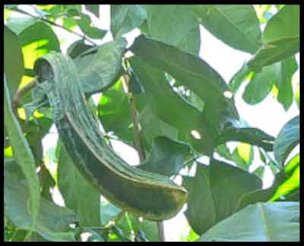From the Rare Fruit Club WA
by Barry Madsen

Would the real Inga edulis please stand up
Ice cream bean is a South American fruit tree sometimes
seen for sale in Nurseries or growing in Perth and surrounding areas,
but it's not common in WA and there's limited local knowledge regarding
the species. No real development work has been done on them globally,
so there are no named cultivars, and if you manage to source one here
it will be a seedling, inevitably labelled I. edulis.
The
species name comes from the Latin word for 'edible' and the plant you
acquire may ultimately produce edible fruit. The problem is that the
genus consists of around 300 species and about 50 of these produce
edible fruit. The following pictures (taken from Amazon River Fruits:
Flavours for Conservation, Professor N. Smith, R. Vasquez & W.H.
Wust (2007), Missouri Botanical Gardens Press, 272pp), illustrate just
some of the variation in fruit forms of different edible species. See
also a review of this book: the link is in the Essays list. The genus
is divided into 14 sections with I. edulis
in section 12. Most of those shown in the pictures are in other
sections, but as might be guessed from the similar pod morphology, I. ingoides
is also in section 12. So with all these other possible confounding
species that could have slipped into the original sourcing, propagation
and marketing chain somewhere, is it possible to firm up your
confidence that your new plant is what you expect it to be?

With this level of diversity in the genus, the answer to being able to nail it down precisely to edulis is "no", short of using a full taxonomic key. But you can fairly easily exclude many possibilities with a few simple checks:
Early
ones while still in the non-fruiting juvenile period are that the plant
should be pubescent, young shoots should be slightly angular and leaves
paripinnate with 4-6 pairs of leaflets and a winged rachis between
leaflets. Look for a small sessile transversely-compressed
(kidney-shaped) nectary on the upper surface of the leaf rachis between
each pair of leaflets. The terminal pair of leaflets should be larger
than the base pair.
In the flowering stage the axillary
inflorescences should be congested spikes. Flowers should have a
tubular calyx and corolla, with 55-100 stamens (1.5-3cm long) and white
filaments tipped with tiny pale yellow anthers.
When it gets
into the mature fruit-producing stage, the pods should be roughly
cylindrical and longitudinally ribbed, olive-green, indehiscent, and
very long (up to 1m or more) and skinny. In many of the other species
the pods bulge noticeably around each seed whereas in edulis this is much less pronounced In cross-section, the pod should be shaped like a toothed cog.
and
when you open the pods, the seeds should be elongated (2-3cm long X
1-1.5cm wide), longitudinally-oriented, not flattened, and preferably
black.

Correct
identification is not purely academic as many other species don’t taste
quite as nice. Best to be a little cautious when you buy a plant from
retail outlets. Often in these matters of possible confusion, you can
cut through the dilemma of whether you're spending all your management
efforts over some years on raising the real McCoy is to taste a fruit
from a local tree satisfying at least the above criteria, obtain scion
material and graft onto a seedling. Alternatively you can germinate
seeds from such a plant but you may have to wait a little longer for
fruit, they may not be exactly true to type and the tree will want to
be bigger. The final picture is from a tree growing here in the Perth
suburbs showing a pod that clearly is not I. edulis.
 . .
Back to
Ice Cream Bean Page
|
|